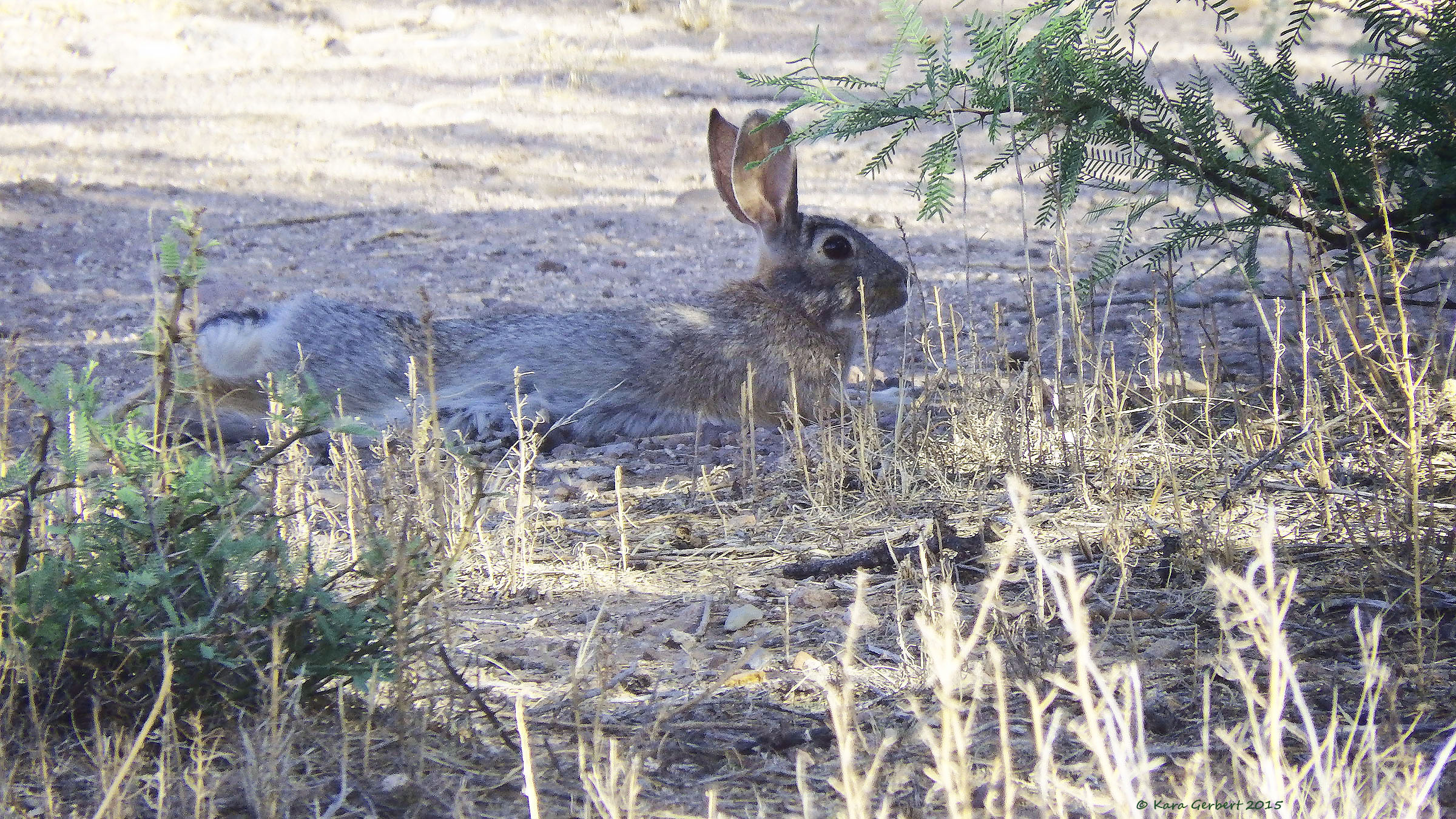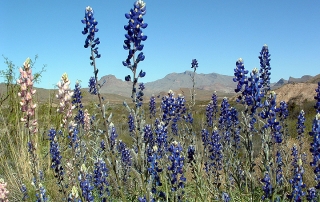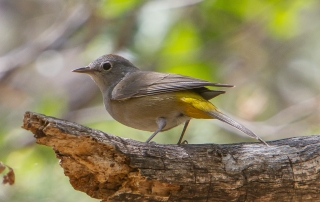Description and checklist for mammals of Big Bend, with 75 species in 23 different families
Mammal Checklist
The mammals of the Big Bend region are extremely diverse. Seventy-five species of mammals, representing 23 families, have been recorded in Big Bend National Park and the Rio Grande Wild and Scenic River. Another six species are listed as hypothetical in the park.
Most Big Bend mammals are nocturnal. Those that are active during daylight hours can usually be seen in the early morning and just before sunset. Three excellent areas to look for large species like deer, javelina (also know as the collared peccary as shown above), mountain lion, fox, and coyote are the Chisos Basin, the area around Panther Junction, and Rio Grande Village.
Information on the abundance of each species comes from wildlife sighting reports by park staff and visitors, and park research reports. Species listed as endangered by the U.S. Fish and Wildlife Service (USFWS) are identified. A listing of endangered indicates the species is in imminent danger of extinction and efforts are being made to ensure its survival as a species.
If you observe a rare, hypothetical, or unlisted mammal, please report it to:
Chief Park Naturalist Panther Junction Big Bend National Park, Texas 79834
or fill out a wildlife observation card at any visitor center.
KEY TO ABUNDANCE
COMMON – Average of more than 100 sightings per year; a mammal that you might see during a visit to Big Bend National Park.
UNCOMMON – Average of fewer than 100 sightings per year.
RARE – Average of fewer than 10 sightings per year.
EXTREMELY RARE – Fewer than 10 sightings during past ten years.
SPECIAL NOTE: Species abundance definitions described above do not apply to bats and most rodents. Abundance ratings for species in these categories are based on records compiled by park researchers.
ORDER INSECTIVORA: SHREWS AND MOLES
FAMILY SORICIDAE: SHREWS
___ Desert Shrew (Notiosorex crawfordi) — RARE
This is Big Bend’s smallest mammal, with an average total length of only 86 mm. Very little is known about the status of this tiny insectivore which occurs only at elevations above 3500 feet.
ORDER CHIROPTERA: BATS
FAMILY MORMOOPIDAE: MORMOOPIC BATS
___ Ghost-faced Bat (Mormoops megalophylla) — UNCOMMON
Occurs throughout the park; roosts mainly in caves. Most bats of this family are restricted to tropical habitats. Wingspread – 14.5 inches.
FAMILY PHYLLOSTOMIDAE: LEAF-NOSED BATS
___ Mexican Long-nosed Bat (Leptonycteris nivalis) — UNCOMMON
Known in the United States only from the Chisos and Chinati Mountains of the Big Bend area, this Mexican species uses the park only during the summer months. It feeds primarily on the nectar of the century plant. Wingspread – 16 inches. Endangered
FAMILY VESPERTILIONIDAE: VESPERTILIONID BATS
___ California Myotis (Myotis californicus)– UNCOMMON
Inhabits the entire park. Unlike most bats, this species remains active during the winter months when it has been found foraging on evenings with temperatures near 40 degrees F. Wingspread – 9 inches.
___ Western Small-footed Myotis (Myotis ciliolabrum) — EXTREMELY RARE
Only one park record. Wingspread – 9 inches.
___ Fringed Myotis (Myotis thysanodes) — UNCOMMON
Occurs throughout the park, most commonly in the lower elevations. Nursery colonies have been found in caves near the Rio Grande. Wingspread – 10.5 to 11.75 inches.
___ Cave Myotis (Myotis velifer) — UNCOMMON
Restricted to the lowland portions of the park. Roosts in caves, old mines, and buildings. Wingspread – 11 to 12.5 inches.
___ Long-legged Myotis (Myotis volans) — RARE
Reported only in the Chisos Mountains within the park. Roosts in trees, crevices, and caves. Wingspread – 10 inches.
___ Yuma Myotis (Myotis yumanensis) — UNCOMMON
Occurs throughout the park, more commonly in the lower elevations near the Rio Grande. More closely associated with water than any other bat species in North America. Wingspread – 9 inches.
___ Western Pipistrelle (Pipistrellus hesperus) — COMMON
One of the most common species in the park, it occurs at all elevations and is often seen flying just before dark. The park’s smallest bat. Wingspread – 8 inches.
___ Big Brown Bat (Eptesicus fuscus) — UNCOMMON
Lives throughout the park, most commonly in Boot Canyon. The species is suspected to be solitary. Roosts mainly in rocky crevices. Wingspread – 9.5 inches.
___ Eastern Red Bat (Lasiurus borealis) — EXTREMELY RARE
Only one park record from a cave in the Chisos Mountains. Wingspread – 12 inches.
___ Hoary Bat (Lasiurus cinereus) — UNCOMMON
A tree roosting bat occasionally found along the Rio Grande floodplain and near springs. One of the first bats to emerge at dusk; found throughout the park. Wingspread – 16 inches.
___ Spotted Bat (Euderma maculatum) — RARE
Big Bend’s most spectacular bat; more spotted bats have been recorded here than anywhere else in Texas. Found throughout the park, but more often in the lower elevations. It’s loud, high pitched call is often heard at night.
___ Townsend’s Big-eared Bat (Plecotus townsendii) — FAIRLY COMMON
Occurs throughout the park; nursery colonies known from both high Chisos Mountains and Mariscal Mountain in the desert. Wingspread – 12.5 inches.
___ Pallid Bat (Antrozous pallidus) — COMMON
This bat is very abundant at Rio Grande Village. At dusk during the warmer months, large numbers can occasionally be seen near the east side of the campground. Known throughout the park, it often hangs from buildings. Wingspread – 15 inches.
FAMILY MOLOSSIDAE: FREE-TAILED BATS
___ Brazilian Free-tailed Bat (Tadarida brasiliensis) — COMMON
Lives throughout the park. It is the most common species at higher elevatons. This is the bat species that is so abundant at Carlsbad Caverns. Wingspread – 12.5 inches.
___ Pocketed Free-tailed Bat (Nyctinomops femorosacca) — RARE
Inhabits only a few lowland areas of the park; thought to be a permanent resident. Wingspread – 14 inches.
___ Big Free-tailed Bat (Nyctinomops macrotis) — UNCOMMON
Occurs throughout the park; possibly a year round resident. Second largest bat in the park. Wingspread – 17 inches.
___ Western Mastiff Bat (Eumops perotis) — RARE
North America’s largest bat. It has been found only near the Rio Grande in the park and is thought to roost in the cliffs of the river canyons and the Sierra del Carmen. Wingspread – 22 inches.
ORDER LAGOMORPHA: HARES AND RABBITS
FAMILY LEPORIDAE: HARE AND RABBITS
___ Desert Cottontail (Sylvilagus audubonii) — COMMON
Inhabits park lands up to about 4700 feet; prefers dense vegetation.
___ Eastern Cottontail (Sylvilagus floridanus) — UNCOMMON
Occurs only above 4700 feet. Slightly larger than the very similar desert cottontail.
___ Black-tailed Jackrabbit (Lepus californicus) — COMMON
Occurs throughout the park in open brushland and in grassy and desert areas up to the Chisos Basin at 5400 feet.
ORDER RODENTIA: RODENTS
FAMILY SCIURIDAE: SQUIRRELS
___ Texas Antelope Squirrel (Ammospermophilus interpres) — COMMON
This very secretive, chipmunk-like ground squirrel occurs throughout the park up to 6100 feet. Most commonly seen along the road into the Chisos Basin.
___ Mexican Ground Squirrel (Spermophilus mexicanus) — EXTREMELY RARE
Occurs only at Rio Grande Village. Few recent records. More commonly seen along highways north of the park.
___ Spotted Ground Squirrel (Spermophilus spilosoma) — UNCOMMON
Occurs mainly in the lowland desert areas; occasionally seen running across the roadway.
___ Rock Squirrel (Spermophilus variegatus) — COMMON
Big Bend’s largest and most common squirrel is often seen in the higher elevations of the Chisos Mountains. Occurs throughout the park, normally in rocky canyons and on mountain slopes.
FAMILY GEOMYIDAE: POCKET GOPHERS
___ Botta’s Pocket Gopher (Thomomys bottae) — COMMON
Occurs throughout the park from 2000 feet up to 6500 feet in Boot Canyon. In the lower elevations often found in association with lechuguilla, an important food plant.
___ Yellow-faced Pocket Gopher (Cratogeomys castanops) — COMMON
Occurs only in sandy, fine textured soils along the Rio Grande and its tributaries. Although pocket gopher burrows are easily found , individuals are seldom seen.
FAMILY HETEROMYIDAE: POCKET MICE AND KANGAROO RATS
___ Silky Pocket Mouse (Perognathus flavus) — UNCOMMON
Occurs mainly in the foothills of the Chisos Mountains. Known only from 1840 feet to 4000 feet. They dig small burrows not more than four inches deep with three or four openings.
___ Nelson’s Pocket Mouse (Chaetodipus nelsoni) — UNCOMMON
Occurs in mountain foothills from 2300 to 5500 feet. Burrows in rocky areas near sotol and chino grama grass.
___ Desert Pocket Mouse (Chaetodipus penicillatus) — COMMON
Occurs only in association with sandy areas from the Rio Grande up to a little over 3000 feet.
___ Merriam’s Kangaroo Rat (Dipodomys merriami) — COMMON
Occurs mainly in the lowlands from the Rio Grande up to 4000 feet. Burrows are easily found in the loose soil that gathers around creosote bush and similar desert shrubs. Occasionally seen crossing the roadways on warm summer nights.
___ Ord’s Kangaroo Rat (Dipodomys ordii) — RARE
Occurs only in association with sandy soils along the Rio Grande, major arroyos, and lowlands.
FAMILY CASTORIDAE: BEAVERS
___ American Beaver (Castor canadensis) — UNCOMMON
Beavers inhabit the Rio Grande and ponds near Rio Grande Village. A population of 134 beavers between the mouth of Santa Elena Canyon and the west end of Boquillas Canyon was estimated in 1978. Beaver slides and feeding sites are often seen on river banks, but the animal itself is seldom seen.
FAMILY MURIDAE: MICE AND RATS
___ Fulvous Harvest Mouse (Reithrodontomys fulvescens) — EXTREMELY RARE
Occurs only in grassland areas of Pine Canyon, Juniper Canyon, and Green Gulch.
___ Western Harvest Mouse (Reithrodontomys megalotis) — UNCOMMON
Occurs only in dense grassland areas between 2500 and 6700 feet.
___ Plains Harvest Mouse (Reithrodontomys montanus) — EXTREMELY RARE
Only one record from the northern part of the park.
___ Brush Mouse (Peromyscus boylii) — UNCOMMON
An excellent climber, this mouse is restricted to the higher elevations above 4500 feet.
___ Cactus Mouse (Peromyscus eremicus) — COMMON
Ranges from the Rio Grande up to 5500 feet elevation. Will build nest in clumps of cactus, among rocks, and in the burrows of other animals. Often seen at Chisos Basin Amphitheater evening programs.
___ White-footed Mouse (Peromyscus leucopus) — RARE
Inhabits wooded or brushy areas in or near riparian habitat such as the Rio Grande floodplain.
___ Deer Mouse (Peromyscus maniculatus) — RARE
Occurs from the Rio Grande up to 3500 feet in desert flats, arroyos, and floodplains.
___ White-ankled Mouse (Peromyscus pectoralis) — UNCOMMON
Inhabits rocky areas above 4000 feet.
___ Mearns’ Grasshopper Mouse (Onychomys arenicola) — EXTREMELY RARE
Only one park record from Gano Spring near Burro Mesa.
___ Hispid Cotton Rat (Sigmodon hispidus) — UNCOMMON
Inhabits lowland moist grassy areas from the Rio Grande up to 3850 feet. Occasionally seen during the day along the Rio Grande Village Nature Trail.
___ Yellow-nosed Cotton Rat (Sigmodon ochrognathus) — UNCOMMON
Occurs only in the higher elevations from 5000 to 7000 feet. Prefers dense stopa grass meadows but can also be seen in grassy areas along the Lost Mine Trail above the Juniper Canyon Overlook. Active during the day. Becomes common as low as Green Gulch during wet years when rapid reproduction occurs.
___ White-throated Woodrat (Neotoma albigula) — COMMON
Occurs at higher elevations from 3700 to 7000 feet. Builds large nests made of small pieces of wood, rocks, and dead lechuguilla leaves, usually within a clump of prickly pear cactus.
___ Mexican Woodrat (Neotoma mexicana) — RARE
Occurs only on high rocky slopes of Emory Peak and Rosillos Peak.
___ Southern Plains Woodrat (Neotoma micropus) — UNCOMMON
Inhabits lowland areas from the Rio Grande up to 3500 feet.
___ House Mouse (Mus musculus) — EXTREMELY RARE
Status in Big Bend is very questionable. One record only from the Chisos Basin. This species was introduced from the Old World.
FAMILY ERETHIZONTIDAE: NEW WORLD PORCUPINES
___ Porcupine (Erethizon dorsatum) — RARE
Most park observations are from lowland desert and grassland areas and along the Rio Grande.
FAMILY MYOCASTORIDAE: MYOCASTORIDS
___ Nutria (Myocastor coypus) — RARE
First reported for the Trans-Pecos in 1985 along the Rio Grande in the Lower Canyons. This alien species is well established in the Del Rio area and many areas of East Texas. Animals have recently been reported from Boquillas Canyon and Rio Grande Village.
ORDER CARNIVORA: CARNIVORES
FAMILY CANIDAE: CANIDS
___ Coyote (Canis latrans) — COMMON
Lives throughout the park, rarely above 5000 feet. Easily observed in the vicinity of the Rio Grande Village Campground.
___ Swift or Kit Fox (Vulpes velox) — RARE
Occurs only below 5000 feet, mainly in the more open portions of the desert. The best field mark is a black-tipped tail without a black line along the top.
___ Common Gray Fox (Urocyon cinereoargenteus) — COMMON
The most common carnivore in the park, it readily climbs cliffs and trees. Its droppings are commonly found on trails and in arroyos. Occasionally heard making cat-like vocalizations. Often confused for the rarely seen swift or kit fox.
FAMILY URSIDAE: BEARS
___ Black Bear (Ursus americanus) — COMMON
Extirpated from the area prior to establishment of the park, black bears began to reestablish a resident population in the Chisos Mountains in the mid-1980’s. Campers should take proper precautions to prevent bears from seeking food in and around campsites.
FAMILY PROCYONIDAE: PROCYONIDS
___ Ringtail (Bassariscus astutus) — UNCOMMON
Because ringtails are secretive, few individuals are seen. They are probably more common than reports indicate. Droppings are commonly encountered along Chisos Mountains trails.
___ Common Raccoon (Procyon lotor) — LOCALLY COMMON
Occurs mainly in riparian areas in the lowlands and along the Rio Grande.
___ White-nosed Coati (Nasua narica) — EXTREMELY RARE
A wandering migrant from Northern Mexico, it was occasionally seen in the 1980’s but there have been no sightings in the park in recent years.
FAMILY MUSTELIDAE: MUSTELIDS
___ Long-tailed Weasel (Mustela frenata) — RARE
The Southwestern race of the long-tailed weasel has a white band on the face. Known throughout the park, it is extremely secretive, but may be more common than records indicate.
___ American Badger (Taxidea taxus) — RARE
Occurs only in the lowlands, rarely above 4000 feet. Diggings often seen in desert areas.
___ Western Spotted Skunk (Spilogale gracilis) — RARE
Lives at all elevations throughout the park. Does a hand-stand on forelegs as an intimidation measure when agitated. Spray may follow.
___ Hooded Skunk (Mephitis macroura) — EXTREMELY RARE
The only park record is from McKinney Spring.
___ Striped Skunk (Mephitis mephitis) — COMMON
Often seen in campground areas at night. Found throughout the park.
___ Common Hog-nosed Skunk (Conepatus mesoleucus) — RARE
Occurs throughout the park up to 7000 feet and is usually found near permanent water. Presence indicated by overturned rocks and small diggings near century plants.
FAMILY FELIDAE: CATS
___ Mountain Lion (Felis concolor) — COMMON
Occurs throughout the park; most sightings are of lone animals crossing the road in Green Gulch and the Chisos Basin. It has been the subject of intensive park research. Attacks on humans occurred in 1984 and 1987. Check with a ranger before hiking in the Chisos Mountains.
___ Bobcat (Lynx rufus) — UNCOMMON
Big Bend’s most common cat, although most cat sightings are of the larger mountain lion. Lives throughout the park, mainly in brushy areas near water.
ORDER ARTIODACTLYA: EVEN-TOED UNGULATES
FAMILY SUIDAE: PIGS
___ Feral Pig (Sus scrofa) — EXTREMELY RARE
Not yet established in the park, but increasing in numbers over the entire Trans-Pecos region. All feral pigs are descendants of escaped domestic pigs that have become secondarily wild. These pigs have a visible tail. Color varies.
FAMILY DICOTYLIDAE: PECCARIES
___ Collared Peccary (Tayassu tajacu) — COMMON
Locally referred to by the Spanish name Javelina, pronounced ha-va-lean-a. Javelinas usually travel in groups of 2-22 animals. Group sizes are larger during the cooler months. Peccaries do not have tails. All individuals are dark with a white collar.
FAMILY CERVIDAE: CERVIDS
___ Elk or Wapiti (Cervus elaphus) — EXTREMELY RARE
Occasionally seen in the Rosillos Mountains area, the elk are probably wanderers from established herds in the Glass and Del Norte Mountains north of Big Bend National Park. A breeding population is not established in the park.
___ Mule Deer (Odocoileus hemionus) — COMMON
Desert dwellers. Most common in the vicinity of springs surrounding the Chisos Mountains, and in the Panther Junction area.
___ White-tailed Deer (Odocoileus virginianus) — COMMON
Only in the Chisos Mountains and foothills. The race in Big Bend National Park, the Carmen Mountains whitetail, is one of the smallest subspecies of whitetail in North America.
FAMILY ANTILOCAPRIDAE: PRONGHORN
___ Pronghorn (Antilocapra americana) — UNCOMMON
Known only to the lowland areas, it is most commonly seen in the Tornillo Flats area between Panther Junction and Persimmon Gap.
FAMILY BOVIDAE: BOVIDS
___ Bighorn Sheep (Ovis canadensis) — EXTREMELY RARE
Extirpated from the immediate area prior to park establishment in 1944. The Texas Parks and Wildlife Department is presently having success with reintroductions to the north of the park, and is attempting to establish desert bighorns east of the park. Reports from the past 20 years may reflect animals reintroduced by the state.
___ Barbary Sheep (Ammotragus lervia) — RARE
Often misidentified as a desert bighorn, this exotic species has increased in recent years. Animals found in the park originate from area ranches where they were introduced as exotic game. May be found throughout the park. Also known as aoudad.
HYPOTHETICAL SPECIES
ORDER MARSUPIALIA: OPOSSUMS
FAMILY DIDELPHIDAE: OPPOSSUMS
___ Virginia Opossum (Didelphis virginiana)
A lone individual was discovered in the Chisos Basin in June of 1982. A second series of sightings was reported from October 1985 to March 1986.
ORDER XENARTHRA: ARMADILLOS AND SLOTHS
FAMILY DASYPODIDAE: ARMADILLOS
___ Nine-banded Armadillo (Dasypus novemcinctus)
Reports of this species from the Terlingua area and other parts of the Trans-Pecos have been previously written off as being of captives released from other parts of Texas. This was thought to be the case when a dead individual was discovered in the Rio Grande Village campground in December of 1983. Because armadillos have been reported crossing bodies of water by walking under water, it is possible that the individual found at Rio Grande Village may have crossed the Rio Grande from Northern Coahuila, Mexico, where armadillo were reported by Starker Leopold in 1959.
ORDER RODENTIA: RODENTS
FAMILY MURIDAE: MICE AND RATS
___ Common Muskrat (Ondatra zibethicus)
Possibly present in the Rio Grande in Big Bend before park establishment in 1944. Two unconfirmed sightings from near Lajitas in 1975.
ORDER CARNIVORA: CARNIVORES
FAMILY CANIDAE: CANIDS
___ Gray Wolf (Canis lupus)
Extirpated from the wild throughout the Southwestern United States, the status of the Mexican Wolf (a subspecies of Gray Wolf) in Northern Mexico is uncertain. Two lone males killed on separate ranches north of the park in 1970 are the last confirmed sightings in the vicinity of Big Bend National Park. A captive population is maintained by the U.S. Fish and Wildlife Service as a source for eventual reintroduction into the wild. Some of the captive wolves may be reintroduced to sites in Arizona and New Mexico. Endangered.
FAMILY FELIDAE: CATS
___ Ocelot (Felis pardalis)
A migrant animal from Mexico, it occurs in small numbers in Coahuila, Mexico, and other border states. Species has never been documented in the Trans-Pecos by photograph or specimen. Endangered.
___ Jaguarundi (Felis Yagouaroundi)
Reports from the park are fairly common but have never been confirmed. The species has never been documented in the Trans-Pecos by either a specimen or photograph. Endangered.
To learn more about the mammals of Big Bend National Park you may obtain the following publications from the
Big Bend Natural History Association P.O. Box 196 Big Bend National Park, TX 79834.
Naturalist’s Big Bend by Roland Wauer
National Audubon Society Field Guide to North American Mammals by John O. Whitaker, Jr.
Peterson Field Guides – Mammals by William H. Burt and Richard P. Grossenheider
Mammals of the Southwest Deserts by George Olin
The Mammals of Texas by William B. Davis and David J. Schmidly
The first published list of park animals was compiled by Adrey E. Borell and Monroe D. Bryant in 1942 as part of a survey for the proposed national park.
Additional list by Dr. David Easterla, 1973.
Revised by park staff 1983, 1989, and 1997.
Reviewed by Dr. James Scudday.
This resource is based on the following source:
Easterla, D.A. 1973. Mammal checklist, Big Bend National Park, Rio Grande Wild and Scenic River. Big Bend Natural History Association in cooperation with the National Park Service. Unpaginated.
This resource should be cited as:
Easterla, D.A. 1973. Mammal checklist, Big Bend National Park, Rio Grande Wild and Scenic River. Big Bend Natural History Association in cooperation with the National Park Service. Unpaginated. Jamestown, ND: Northern Prairie Wildlife Research Center Home Page. http://www.npwrc.usgs.gov/resource/othrdata/chekbird/r2/bendmam.htm








